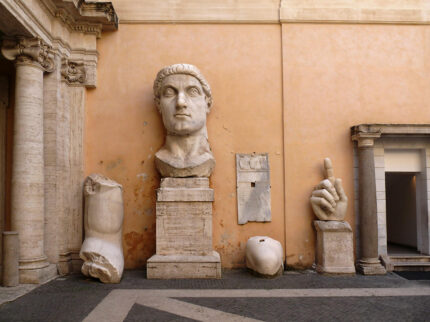 In the entrance courtyard of the Palazzo dei Conservatori at the top of the Capitoline Hill in Rome, visitors are greeted by the gigantic head, hands, forearm, shin, knee and feet of the Emperor Constantine. They are what remains of a colossal acrolithic statue of Constantine that once sat ponderously in the western apse of the Basilica Nova, the great civic building started by Maxentius in 307 A.D. and completed by Constantine after his victory over Maxentius in the Battle of the Milvian Bridge in 312 A.D.
In the entrance courtyard of the Palazzo dei Conservatori at the top of the Capitoline Hill in Rome, visitors are greeted by the gigantic head, hands, forearm, shin, knee and feet of the Emperor Constantine. They are what remains of a colossal acrolithic statue of Constantine that once sat ponderously in the western apse of the Basilica Nova, the great civic building started by Maxentius in 307 A.D. and completed by Constantine after his victory over Maxentius in the Battle of the Milvian Bridge in 312 A.D.
The head, arms and legs of the colossus were carved out of white marble. The body of the emperor, posed seated and enthroned, was made of a wooden framework over a brick core. The body was then bronzed, possibly gilded, in a glittering contrast to the marble extremities. The head alone is more than eight feet high. Extrapolating from the surviving fragments, the intact statue was an astonishing 40 feet high.
The statue was built between 312 and 315 A.D., with the facial features and hands reworked (there are two right hands) around 325 A.D. It was destroyed in Late Antiquity, its bronze looted and melted down, the marble parts broken and abandoned in the ruin of the basilica. The marble pieces were rediscovered in 1486 and placed in the courtyard of Palazzo dei Conservatori by Michelangelo when he was building Piazza del Campidoglio in 1536–1546.
In 2022, the Factum Foundation in collaboration with the Musei Capitolini and supported by the Fondazione Prada, embarked on a new digitization project to document the fragments and recreate a full-scale replica of the Colossus of Constantine for a new exhibition. In March of 2022, the ten fragments in the courtyard were recorded in ultra-high resolution with photogrammetry and LiDAR technology. The data was used to create a 3D model of the fragments and fill in the missing blanks.
Factum Arte experts worked with museum curators to recreate the statue’s original pose (back when it had one right hand and one left hand) and draping of the paludamentum cloak that covered the emperor’s body. Existing (much smaller) statues of emperors and gods in the same enthroned pose were used as references. By May, the team was ready to go from digital modeling to physical reconstruction.
It was decided to visually distinguish the facsimile fragments from the digitally reconstructed body and cloak.
The recorded digital data of each fragment was rematerialised as 1:1 3D prints, which were used to make positive casts in reinforced resin. The surface was coated with a custom gesso mix and painted to resemble the original marble, weathered by the exposure to the elements. The result was perfect facsimiles of the original fragments.
The recreated sections of the body were made in polyurethane, coated in several layers of resin mixed with marble powder and mica, to achieve a clean neutral marble-white colour. The cloak was made in milled polystyrene, coated with acrylic resin mixed with bronze powder, over which a distressed gold foil gilding was applied.
The final tally was 30 sections of the Colossus. They were craned into the exhibition room at the Fondazione Prada in Milan where the statue was assembled for the exhibition Recycling Beauty.
This video gives a glimpse into the digital reconstruction process.
In this video, archaeologist Darius Arya goes into detail about the history of the Colossus, its original context in the Basilica Nova and visits the recreation. It’s awe-inspiring to see the iconic fragments put back together.
since when is “craned” a verb?
According to the OED, since the late 16th century, when used in the sense in which this post uses it. But I don’t suppose you’re really interested.
Well, copies of this recreation will probably not be for sale in the gift shop 🙂
It’s great they went from digital representation to physical recreation!
The ‘Aula Palatina’, the still existent Basilica of Constantine at Trier in Germany, is a palace basilica built between 300 and 310AD. Its hall has a length of 67m, a width of 26m and a height of 33m. Augusta Treverorum near the strategic Rhine border was one of the four tetrarchic Roman capitals.
However, the ‘Basilica Nova’ in Rome was built just a little later, i.e. in between 307 and 313AD. Here, its central nave was 80m long, 25m wide, 35m high, but with aisles 16m wide and 24.5m high. Of course, leftover gargantuan “acrolithic” marbles of gods “in enthroned pose” were in Rome much easier to come by.
After Constantine had moved his base to ‘Constantinople’, the conversion must have been more straight forward. From 386AD, for example, there is a (pagan) complaint letter to Emperor Theodosios in what is now Istanbul (Libanios 30: “Προς Θεοδόσιον τον βασιλέα υπέρ των ιερών”).